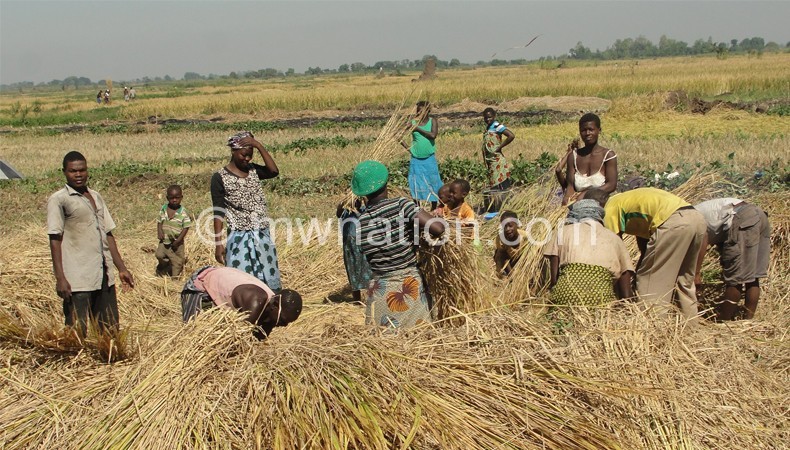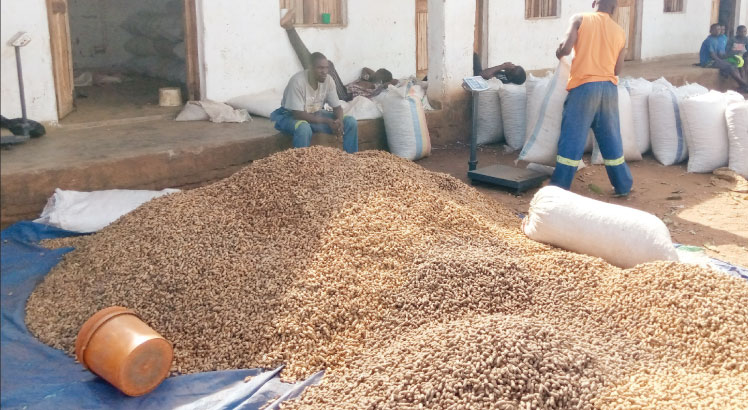No easy walk for rice farmers in absence of infrastructure
Jayson Phiri, treasurer for Msenjere Rice Growers Association in Nkhotakota, talks with enthusiasm and vigour, quoting feats of the association since the clubs formation in 2011/12 farming season.
From 150 members (90 males and 60 females) then, the association membership has grown steadily to 510 who each cultivate a 0.2 hectare.
There are 214 males while 296 are females now, narrated Phiri during a media tour facilitated by the Civil Society Agriculture Network (CisaNet) with funding from Inter Church Organisation for Development Cooperation (ICCO) recently.
“Most of the activities in rice production are conducted by women and we are proud that women are topping the numbers here,” he said.
In Malawi, anecdotal information suggests that women carry out about 90 per cent of all agricultural production activities while men tend to dominate the marketing activities in the smallholder sub-sector.
He continued, in the 2014/15 farming season, the association amassed 125 metric tonnes of the long and aromatic Kilombero grain, the most preferred rice variety in the country, a significant drop where compared to 520 metric tonnes in the 2013/14.
The Ministry of Agriculture, Irrigation and Water Development in its Agricultural Production Estimates Survey (Apes) for the 2014/14 agricultural season show rice registered a decrease of 13.6 percent.
Falling production
The decrease is attributed to a number of weather-related hazards. The start of season delayed by about 30 to 40 days due to late onset of rains which delayed planting of all major crops across the country. The delayed onset of rains was followed by heavy rains that the country received in January this year, resulting in widespread floods and wash-aways.
The country also experienced dry spells in most districts for a period of about four to six weeks, between February and March 2015, which resulted in early tail-off of the rains. This early tail-off affected crop development resulting in low yields/production of most crops and this did not spare Msenjere Rice Growers Association members.
But even the little 125 metric tonnes of rice is under threat as respective members keep the produce in their homes because the association does not have infrastructure for proper storage. And the state worries Phiri.
“Storage space is limited and this renders the associations to have no control over harvested rice as storage is done by individual farmers who engage in side-selling at the expense of group selling,” he complained.
Experts identify lack of proper storage space for rice farmers as one of major constraints on rice production and marketing.
“As a result, farmers sell all of their rice very quickly after harvest, which means they fetch a much lower price than at other times of year,” he said. It thus becomes difficult for the marketing leaders to quantify the rice being kept by the individual members and quality of rice is compromised.
“We need to have access to collective storage facilities to keep our rice for a long time and then sell it when prices are higher. But we do not have the facility. We were allocated the land to build our own facility, but we have neither expertise nor capacity,” explained Phiri, fearing that their desire to form a cooperative to value add to their produce might just be another dream.
He added that farmers are willing to contribute to the development of the structure, but would appreciate to partner with a public or private company to turn the fortunes of the association.
“We are willing to share the cost of these facilities and we would be glad if a potential partner is identified,” he said.
Phiri’s fears are confirmed by the National Rice Development Platform chairperson Professor David Kamchacha who explained that minimal storage capacity among the smallholders is hampering farmers from taking advantage of seasonal price hikes.
“As a result, the rice farmers end up being the price-takers as they enter the market at the lowest point in the seasonal price,” said Kamchacha at the National Rice Marketing Conference and Fair held in July this year.
“This situation of immediate post-harvest crop sales is also unhelpful for the processors as they have to find capital to purchase in bulk, within a short period of the season rather than make purchases at intervals throughout the season,” he added.
Access to storage facilities
The status quo is, however, different at Bua Rice Growers and Marketing Cooperative in Nkhotakota and Lifuwu Rice Growers Cooperative in Salima where farmers have access to reliable warehousing. But they too have their own concerns.
For instance, Lifuwu Rice Growers Cooperative which has 175 members with a potential of producing 350 metric tonnes of rain-fed rice has a warehouse that can only take 50 metric tonnes.
A member is only allowed to deposit 10 bags each weighing 50 kg at the cooperative warehouse rented from the Lifuwu Research Station while at Bua the reprieve is that the cooperative work hand in hand with the Water Users’ Association which has leased the warehousing facility at no cost for now.
Marriam Bwanali, vice secretary of Lifuwu Rice Growers Cooperative in Salima has urged authorities promoting production of rice to also consider developing a storage investment engagement plan.
“Authorities should lay out a strategy for working with the private sector to encourage them build more and durable storage facilities for rice. Otherwise, we are producing enough, but we don’t have enough storage capacity.”
Perhaps it is time the warehouse receipt system facilitated by ACE and AHCX was introduced to rice associations and cooperatives in the country. Under this system, the farmers can deposit their rice at a warehouse run by a private business at a fee, but they can also use the rice deposit as collateral to access credit from the banks.
CisaNet executive director Tamani Nkhono-Mvula said investment in infrastructure development is a critical element to successful agricultural development. Successful strategies for the improved infrastructures must not only focus on new technologies, but also on creating policies and regulations that encourages the investment in infrastructure.
“Small-scale irrigation development coupled with access to long-term finance, access to markets and commercial farming expertise by producers will go a long way in achieving food security and overall economic development. Access to storage facilities enhances farmer’s incentive to adopt modern seed varieties that can enhance staple crop production and food security,” he said.
It is worth noting that a 10-kilometre bitumen road is under construction to Lifuwu Rice Growers Cooperative from the Salima-Senga-bay road.
Improved infrastructure, including rural roads, rural electrification, irrigation and storage facilities, links small producers to markets and reduces their risks and transaction costs.
It does not only save time in transporting water, crops and other products that farmers produce but it also increases the volume of marketable goods and reduces costs for inputs needed to produce these costs. n





